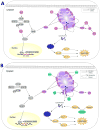Getting the "Kill" into "Shock and Kill": Strategies to Eliminate Latent HIV
- PMID: 29324227
- PMCID: PMC5990418
- DOI: 10.1016/j.chom.2017.12.004
Getting the "Kill" into "Shock and Kill": Strategies to Eliminate Latent HIV
Abstract
Despite the success of antiretroviral therapy (ART), there is currently no HIV cure and treatment is life long. HIV persists during ART due to long-lived and proliferating latently infected CD4+ T cells. One strategy to eliminate latency is to activate virus production using latency reversing agents (LRAs) with the goal of triggering cell death through virus-induced cytolysis or immune-mediated clearance. However, multiple studies have demonstrated that activation of viral transcription alone is insufficient to induce cell death and some LRAs may counteract cell death by promoting cell survival. Here, we review new approaches to induce death of latently infected cells through apoptosis and inhibition of pathways critical for cell survival, which are often hijacked by HIV proteins. Given advances in the commercial development of compounds that induce apoptosis in cancer chemotherapy, these agents could move rapidly into clinical trials, either alone or in combination with LRAs, to eliminate latent HIV infection.
Keywords: Akt inhibitors; Bcl-2 antagonists; HIV cure; HIV latency; PI3K inhibitors; RIG-I inducers; Smac mimetics; XIAP inhibitors; apoptosis; latency reversing agents; pro-apoptotic drugs; shock and kill.
Copyright © 2017 Elsevier Inc. All rights reserved.
Conflict of interest statement
SL’s institution has received funding for investigator-initiated industry-sponsored studies from Merck, Gilead, Viiv Healthcare and Tetralogic, for educational activities from Merck, Viiv and Gilead, and has also acted on the advisory board for and as consultancy to Callimune, Tetralogic, and InnaVirVax. SL, JA and YK collaborate with Infinity Pharmaceuticals to test the impact of compounds on HIV latency. There are no other conflicts of interest.
Figures




References
-
- Adams JM, Cory S. The Bcl-2 protein family: arbiters of cell survival. Science. 1998;281(5381):1322–6. - PubMed
-
- Aillet F, Masutani H, Elbim C, Raoul H, Chene L, Nugeyre MT, Paya C, Barre-Sinoussi F, Gougerot-Pocidalo MA, Israel N. Human immunodeficiency virus induces a dual regulation of Bcl-2, resulting in persistent infection of CD4(+) T- or monocytic cell lines. J Virol. 1998;72(12):9698–705. - PMC - PubMed
-
- Amaravadi RK, Schilder RJ, Martin LP, Levin M, Graham MA, Weng DE, Adjei AA. A Phase I Study of the SMAC-Mimetic Birinapant in Adults with Refractory Solid Tumors or Lymphoma. Mol Cancer Ther. 2015;14(11):2569–75. - PubMed
Publication types
MeSH terms
Substances
Grants and funding
LinkOut - more resources
Full Text Sources
Other Literature Sources
Medical
Research Materials

